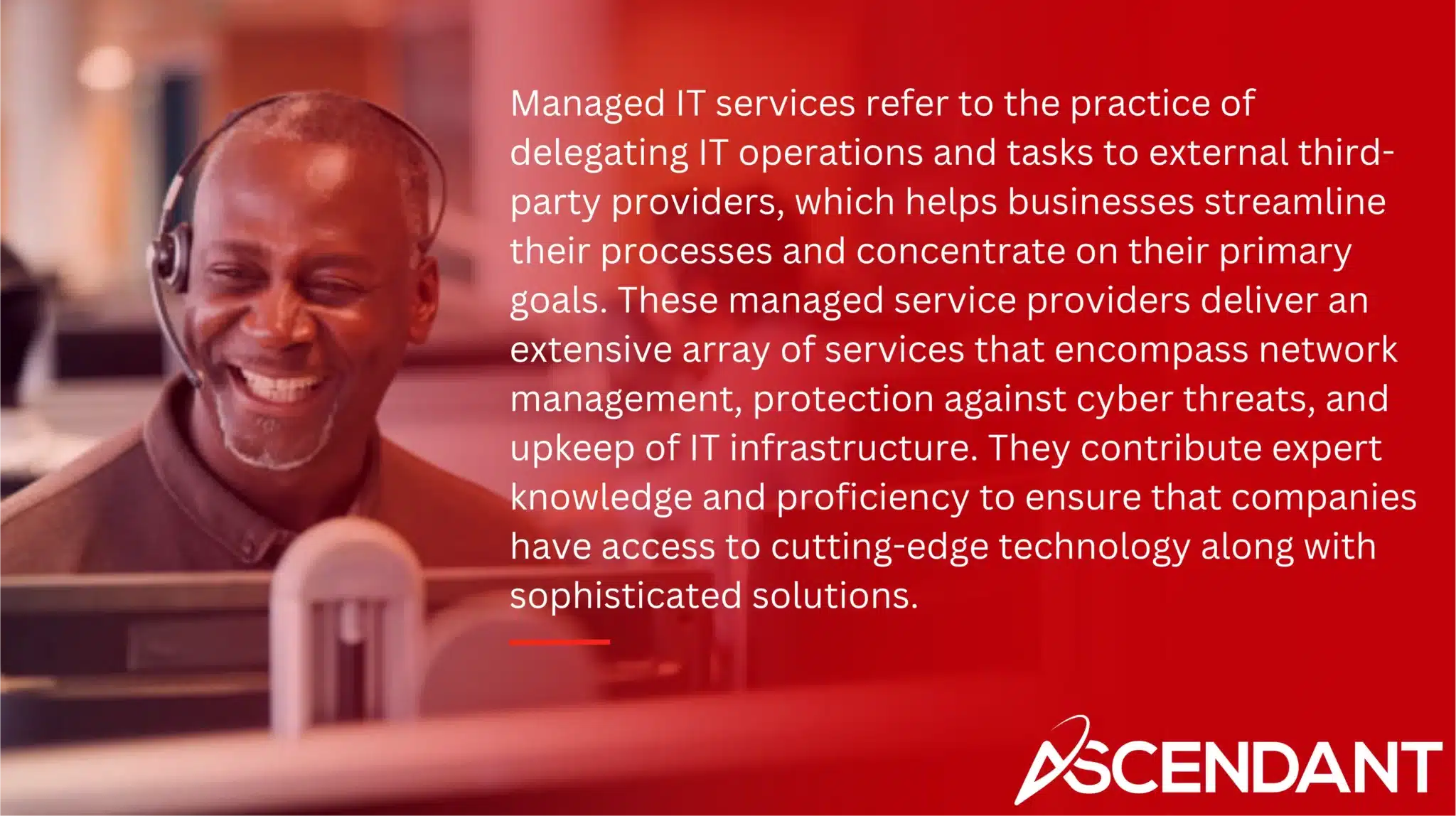Deciding between managed IT services vs internal IT team? This comparison will help you understand the pros, cons, and costs involved, ensuring you make the best choice for your business.
In This Article:
- Understanding Internal IT
- What Are Managed IT Services?
- Comparing Costs
- Flexibility and Scalability
- Security Considerations
- Customization and Control
- Hybrid Approach: Combining Managed IT Services and Internal IT
- Choosing the Right Option for Your Business
Key Takeaways
- Internal IT teams provide greater control and customized solutions but face challenges like high operational costs and the difficulty of finding qualified talent.
- Managed IT services can offer cost savings, access to advanced technology, and round-the-clock support, although they may result in reduced control over IT operations.
- A hybrid approach, combining in-house IT with managed services, allows businesses to balance cost efficiency and control while adapting to changing technology needs.
Understanding Internal IT
An internal IT department is made up of an in-house team tasked with overseeing a company’s technology requirements. This group dedicates itself to the development, upkeep, and assistance of the organization’s IT systems, applications, and networks to ensure seamless operations. The various roles that make up this internal team can include duties such as network management, cybersecurity measures, software engineering tasks and providing technical help.
The scope of an internal IT department can significantly fluctuate based on factors like user quantity, complexity within the IT infrastructure setup or how much work is contracted out. Working intimately alongside other segments within the company allows for a unified strategy towards effective it management.
Companies are presented with two choices: either construct their own teams internally to handle all aspects related to information technology or engage managed service providers—external entities specialized in meeting those needs—which present distinct advantages and potential drawbacks.
Benefits of Internal IT
Maintaining an in-house IT team offers significant control over the management and functionality of a business’s IT infrastructure. This close governance allows for seamless integration of technology strategies with broader business objectives, ensuring that any technical challenges can be swiftly tackled to reduce downtime and bolster operational efficiency.
With on-site availability, support from internal IT professionals is consistently accessible, resulting in expedited reaction times when problems occur. The ability to monitor systems proactively and respond immediately is essential for sustaining uninterrupted operations and mitigating extended periods of disruption through continuous vigilance and active support measures.
An internal IT group has the capacity to craft customized solutions specifically designed for the unique demands of the company. Such tailored technology strategies are intricately aligned with the particular goals and needs of a business, furnishing it with a considerable advantage over competitors who may not have such personalized systems at their disposal.
Challenges of Internal IT
Internal IT operations, while advantageous, encounter numerous obstacles. Constraints in resources can create bottlenecks and protracted response times. Securing skilled IT professionals is an additional obstacle that complicates the assembly of a proficient team equipped with the necessary skills and expertise. A lack of varied know-how may hinder these internal teams’ ability to tackle intricate IT problems adeptly.
The costs associated with sustaining an internal IT department might surpass initial estimates when factoring in various expenditures such as employee wages, benefits, and training initiatives. The cumulative financial burden from staff expenses—encompassing salaries, health care perks, vacation pay-outs, retirement plans like 401k contributions, payroll taxes—as well as continuous professional development programs can be substantial.
Even though having cybersecurity personnel on-site allows for tighter oversight and swifter reaction to security risks, it requires a significant allocation of both monetary assets and human capital. These challenges are formidable enough to substantially hinder the efficacy of internal IT functions.
What Are Managed IT Services?
Managed IT services refer to the practice of delegating IT operations and tasks to external third-party providers, which helps businesses streamline their processes and concentrate on their primary goals. These managed service providers deliver an extensive array of services that encompass network management, protection against cyber threats, and upkeep of IT infrastructure. They contribute expert knowledge and proficiency to ensure that companies have access to cutting-edge technology along with sophisticated solutions.
The significance of these services stems from their capacity to offer consistent support round-the-clock alongside specialized expertise—key for enterprises functioning outside typical business hours. Such continuous assistance guarantees swift resolution of any problems, thereby reducing operational disruptions and preserving the flow of business activities.
Advantages of Managed IT Services
Managed IT services offer substantial cost advantages by eliminating the need for businesses to employ a full-time, in-house team. This approach not only trims operational costs, but also introduces a more stable monthly expense model. Managed services providers bring specialized expertise that empowers organizations to efficiently handle intricate projects without the necessity of expansive hiring within their own ranks.
By partnering with managed service providers, companies gain entry to state-of-the-art technology and sophisticated tools that boost operational performance. Such access propels businesses forward, giving them a competitive advantage as they stay abreast of evolving industry trends. These benefits permit enterprises to concentrate on their primary business functions while entrusting the complexities of IT management to seasoned professionals in managed services.
Potential Drawbacks of Managed IT Services
Managed IT services come with certain disadvantages. When businesses outsource their IT operations, they might experience diminished command over their IT infrastructure. Such a decrease in control can be troubling for companies that favor hands-on management of their technology solutions. Should the internal IT staff not be at hand, there’s a risk of operational delays due to dependence on external managed IT services.
Opting for managed IT services may also incur higher costs and require more time compared to maintaining an in-house IT department—this is particularly true when the needed services are complex and called upon regularly. Thus, it’s crucial for businesses to thoroughly assess these potential downsides while contemplating the adoption of managed IT services as a viable alternative.
Comparing Costs
Assessing the full spectrum of expenses for internal IT management is critical, taking into account staff salaries, equipment, software solutions, and facility overheads. These costs tend to stack up considerably and can render an in-house approach quite expensive for a multitude of businesses. Managed IT services stand as an alternative that offers more budget-friendly options while maintaining adherence to industry standards such as CMMC and DFARS.
Unlike fluctuating costs associated with managing an in-house team where expenses can vary unpredictably, managed IT services introduce financial stability by employing fixed fee models. This facilitates organizations using these services to enjoy steady monthly charges which aid significantly in streamlining their fiscal planning.
A transition from self-managed IT operations to outsourced managed IT services often results in cost reductions for companies—potentially cutting down expenditures by as much as 30%. Such savings underscore the substantial economic advantages that could be reaped by opting for managed service providers.
Flexibility and Scalability
The ability for IT services to be adaptable allows companies to swiftly modify their approach in alignment with distinct pathways of business expansion and incorporate cutting-edge technologies without disruption. By contracting with a managed service provider, firms are able to scale their IT capabilities according to evolving requirements, including the resources offered by the managed service. This level of flexibility is vital for businesses undergoing rapid growth or those that see seasonal surges in demand as they expand.
Ensuring that an organization’s IT infrastructure can expand while maintaining both efficiency and security is essential when experiencing growth. Managed IT services grant access to additional resources needed for handling growing workloads without necessitating large initial investments in physical hardware systems. Such scalability proves particularly advantageous during periods of peak operation, offering the necessary elasticity to oversee substantial projects or navigate through times of intensified usage demands effectively.
Security Considerations
In light of the escalating cyber threats that organizations are encountering, it’s vital to prioritize cybersecurity. A proficient managed service provider is expected to deliver an all-encompassing array of cybersecurity solutions, which should consist of cutting-edge security measures along with continuous training designed to keep pace with the ever-changing nature of these threats. Such services play a crucial role in safeguarding businesses against malicious digital activities and enable them to react promptly when security incidents arise, particularly those related to network security.
Adhering to specific industry regulations and standards forms a critical component of managed IT services. Service providers specialized in management can assist companies in fulfilling these stringent compliance obligations effectively, thereby diminishing the likelihood of facing penalties while simultaneously bolstering their overall protection mechanisms.
Nevertheless, issues concerning transparency and accountability may surface for firms utilizing managed service providers’ expertise. Resolving such matters is imperative for reinforcing robust defensive strategies against potential breaches or attacks.
Customization and Control
The decision between utilizing managed IT services and having an in-house IT team is significantly influenced by the desire for customization and control within a business’s operations. Possessing an internal IT team affords greater direct oversight of the IT infrastructure, allowing for swift alterations to ensure that integration and solutions are closely aligned with specific business requirements.
Conversely, managed IT services grant access to a collective pool of professionals who possess specialized knowledge in offering customized solutions designed to meet business needs effectively. Although this could lead to reduced expenses and enhanced process efficiency, it might simultaneously result in relinquishing some degree of control over the management of IT functions.
When determining which path best suits their organization, business owners must consider how much total or complete control they need versus their preference for tailored service offerings. The choice depends on balancing more immediate influence against potentially advantageous external expertise based on what aligns with their unique demands as a business entity.
Hybrid Approach: Combining Managed IT Services and Internal IT
A mixed strategy that fuses the capabilities of an internal IT team with managed services provides a versatile and effective tactic for handling IT management. This structure grants companies access to advanced support from external managed service providers while retaining authority over essential IT functions.
Employing this hybrid method, companies can adapt their resource allocation dynamically in response to evolving demands without relinquishing oversight. The synergy between external managed IT services and in-house IT expertise allows businesses to optimize both financial efficiencies and immediate governance, thereby improving collective output.
Choosing the Right Option for Your Business
Choosing between internal IT teams and managed services is dependent on a multitude of factors, such as the size of the business, required financial investment, and particular technology requirements. Organizations must consider their distinct demands, resource allocation, and primary objectives when deciding on strategies for IT staffing.
When deliberating over in-house versus managed IT services, it’s imperative to take into account essential factors like budget limitations, specific IT needs, and resources at hand. Companies ought to meticulously evaluate these aspects—taking note especially of any limited budgets—to determine which approach best fits their strategic ambitions and day-to-day operational necessities.
Summary
To summarize, harnessing the capabilities of internal IT provides businesses with more direct oversight, swift assistance, and tailored solutions. It may also require significant financial and human resources. On the other hand, opting for managed IT services can lead to reductions in expenses and access to specialized knowledge along with the ability to scale operations effortlessly—albeit potentially at the expense of diminished governance over technological functions.
Businesses must weigh considerations like affordability, adaptability, security measures, and personalization when discerning between these options. A thorough evaluation of a company’s unique requirements will guide them toward an optimal choice that fosters their progression and operational productivity. The decision made here could be pivotal for flourishing amidst our era’s digital evolution.
 Frequently Asked Questions
Frequently Asked Questions
What are the main benefits of internal IT?
Internal IT provides increased governance of the infrastructure and swift assistance, enabling the creation of bespoke solutions that are in harmony with particular business requirements.
This customized strategy notably boosts both efficiency and the ability to respond promptly.
What are managed IT services?
Managed IT services are the outsourcing of IT operations to third-party providers who handle various tasks, including network management, cybersecurity, and infrastructure maintenance.
This approach allows organizations to focus on their core business while ensuring their IT needs are professionally managed.
How do managed IT services save costs?
By offering affordable solutions and steady monthly costs, managed IT services often lead to up to a 30% cost reduction when compared with the expenses of sustaining an in-house IT team.
What are the potential drawbacks of managed IT services?
One potential drawback of managed IT services is the reduced control over IT operations, which might lead to dependency on the service provider and possible operational downtime.
Additionally, costs can sometimes exceed those of an internal IT department.
What is a hybrid approach to IT management?
A hybrid approach to IT management integrates an in-house IT team with managed services, offering a balance of cost-effectiveness and direct control.
This strategy enhances flexibility and efficiency in managing IT resources.


